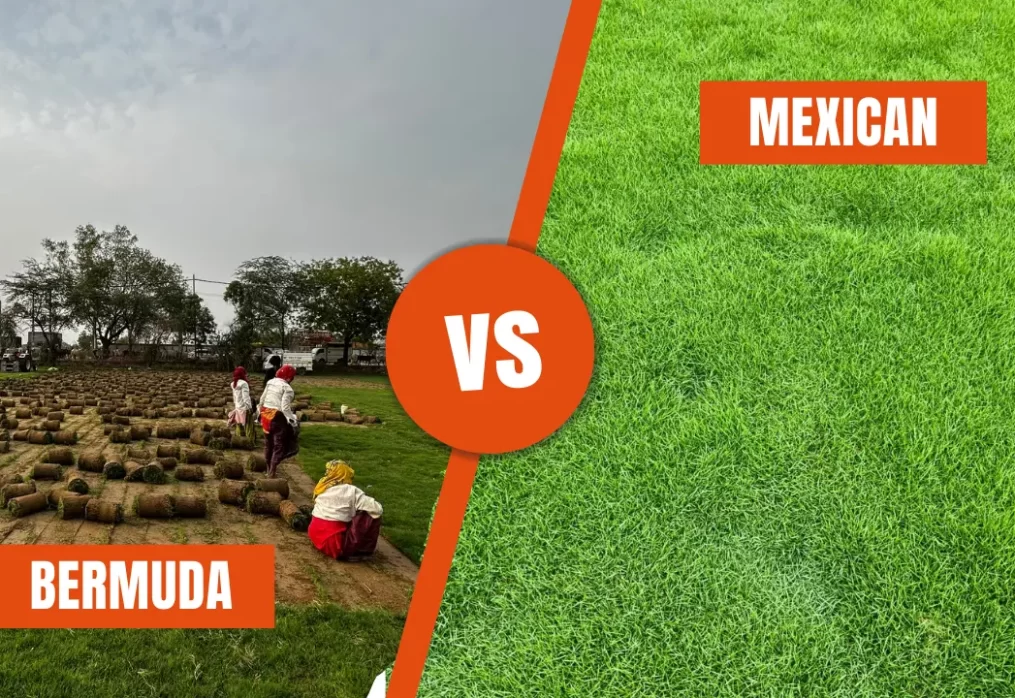Bermuda Grass vs Mexican Grass – Which Suits Indian Climate?
Introduction
When it comes to creating a lush, green lawn in India, the debate often boils down to Bermuda Grass vs Mexican Grass. Both have their unique advantages, but their suitability depends largely on climate, soil, and maintenance preferences. With India’s mix of scorching summers, unpredictable monsoons, and mild winters, making the right choice can save you time, money, and effort.
Let’s break down the pros and cons of each grass type to help you decide which suits Indian conditions better.
Understanding Bermuda Grass
Origin and Background
Bermuda Grass is native to Africa but has spread worldwide due to its hardy nature. It’s among the most popular lawn grasses in India, particularly in cities like Delhi, Mumbai, and Bangalore.
Growth Habits and Appearance
- Medium to fine-textured grass blades
- Dark green color with a dense mat-like growth
- Creeping growth pattern through stolons and rhizomes
Soil and Water Requirements
- Grows best in well-drained sandy or loamy soils
- Tolerates drought well but benefits from regular watering
Understanding Mexican Grass
Origin and Background
Mexican Grass, also known as “carpet grass” in some regions, is widely used for ornamental lawns. Unlike Bermuda, it’s primarily chosen for its beauty rather than durability.
Growth Habits and Appearance
- Very fine, silky texture
- Light green shade with a soft carpet-like feel
- Forms a compact, low-growing cover
Soil and Water Requirements
- Prefers fertile soils with consistent moisture
- Doesn’t tolerate extreme drought as well as Bermuda
Climate Suitability of Bermuda Grass
Bermuda Grass is a warm-season grass, thriving in temperatures between 24°C to 37°C. Perfect for Indian summers, it can withstand scorching heat and bounce back quickly after rain.
- Drought Resistance: Excellent, making it ideal for dry regions like Rajasthan.
- Winter Dormancy: Turns brown in extreme cold but revives in spring.
Climate Suitability of Mexican Grass
Mexican Grass adapts well to moderate climates, but it doesn’t handle harsh droughts like Bermuda.
- Shade Tolerance: Performs better under partial shade compared to Bermuda.
- Heat Sensitivity: Requires extra watering in peak summer.
- Winter Growth: Slows down significantly in cold weather.
Appearance and Aesthetic Appeal
- Bermuda Grass: Dark green, slightly coarse, and gives a sporty look.
- Mexican Grass: Light green, silky, and provides a velvety carpet-like finish.
👉 If you want a lawn that feels luxurious and soft underfoot, Mexican Grass is a winner. For a bold, green, durable look, Bermuda Grass shines.
Growth and Maintenance
- Bermuda Grass: Grows aggressively and spreads quickly. Needs frequent mowing (once a week in summer).
- Mexican Grass: Grows slower, requiring less mowing. However, it needs careful watering to prevent drying.
Durability and Usage
- Bermuda Grass: High durability, perfect for playgrounds, parks, and heavy-use lawns.
- Mexican Grass: More delicate, best for ornamental lawns, gardens, and decorative landscaping.
Water Consumption
- Bermuda Grass: Saves water, can survive with minimal irrigation.
- Mexican Grass: Needs consistent watering, especially during dry spells.
Soil Adaptability
- Bermuda Grass: Thrives in sandy, loamy, and even poor soils.
- Mexican Grass: Requires fertile, nutrient-rich soil for lush growth.
Pest and Disease Resistance
- Bermuda Grass: Prone to weeds like crabgrass but easy to control with mowing and fertilizers.
- Mexican Grass: Can suffer fungal issues in humid conditions; needs well-drained soil.
Cost Comparison in India
- Bermuda Grass Sod Rolls: ₹6–₹12 per sq. ft.
- Mexican Grass Sod Rolls: ₹10–₹20 per sq. ft.
👉 Long-term, Bermuda Grass is cheaper because it requires less care and water.
Which Grass is Better for Indian Homes?
- Budget-friendly lawns: Bermuda Grass wins.
- Decorative gardens: Mexican Grass adds charm.
- High-traffic areas: Bermuda Grass handles wear and tear.
Expert Tips for Grass Selection
- Check how much sunlight your lawn receives daily.
- Consider your water availability—Bermuda saves water, Mexican needs more.
- Think about usage—playgrounds vs show lawns.
- Avoid overwatering Mexican Grass, or it may rot.
- Fertilize Bermuda Grass twice a year for best results.
Conclusion
Both Bermuda Grass and Mexican Grass have their strengths, but the right choice depends on your needs. If you want a tough, low-maintenance, budget-friendly lawn, Bermuda is the way to go. But if you’re aiming for a soft, lush, ornamental lawn and don’t mind extra care, Mexican Grass delivers unmatched beauty.
Ultimately, the Indian climate favors Bermuda Grass for durability and Mexican Grass for aesthetics.
FAQs
1. Which grass grows faster in India?
Bermuda Grass grows faster and spreads aggressively compared to Mexican Grass.
2. Is Mexican Grass good for shaded areas?
Yes, Mexican Grass tolerates partial shade better than Bermuda Grass.
3. Does Bermuda Grass survive Indian winters?
Yes, though it may turn brown in extreme cold, it revives in spring.
4. Which one requires less maintenance?
Bermuda Grass needs more mowing but less watering, while Mexican Grass requires careful watering.
5. Can I mix Bermuda and Mexican Grass?
It’s not recommended because their growth patterns and water needs differ
- How to Grow & Maintain Long-Lasting Lawns in Faridabad Homes - October 4, 2025
- Top Suppliers of Natural Lawn Grass in Punjab - October 1, 2025
- Where to Buy Natural Lawn Grass in Jaipur, Udaipur & Jodhpur - September 30, 2025
